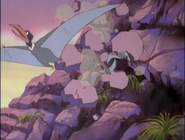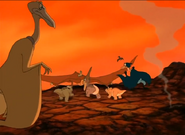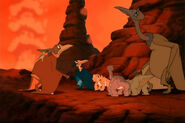Quetzalcoatlus[1] was a huge pterosaur, the largest animal ever to fly. It lived in the Late Cretaceous of North America, 68–66 million years ago.
It was found in Texas, in 1971 and had an estimated wing span of around 10 metres (32 feet), [2] estimated from an incomplete wing. Hatzegopteryx, which may be a second species, was discovered decades later.
Quetzalcoatlus had an unusually long neck, and when it stood on the ground it was as tall as a giraffe. The Quetzalcoatlus was the biggest known flying animal ever.
Description[]
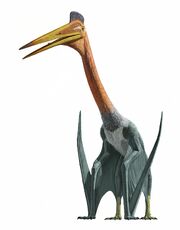
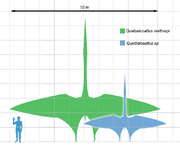
Skull material (from an unnamed smaller species) shows that Quetzalcoatlus had a very sharp and pointed beak, contrary to the first rebuilds that showed a blunt snout, based on the unnoticed inclusion of jaw material from another pterosaur species. A skull crest was there but its exact form and size are still unknown. [3]
Size[]
When it was first found, scientists estimated that the largest Quetzalcoatlus fossils had a wing span as large as 52.2 feet, choosing the middle of three extrapolations from the proportions of other pterosaurs that gave an estimate of 36, 50.85 and 68.9 feet respectively. In 1981, further study dropped these estimates to 36–39 feet.[4] More recent estimates based on greater knowledge of azhdarchid scales place its wing span at 33–36 ft.[5]
Mass estimates for giant azhdarchids are very hard since there are no species that share a similar size or body plan, and so the published results vary widely.[6] While some studies have found really low weight estimates for Quetzalcoatlus, as low as 150 pounds for a 10-meter individual, most estimates published since the 2000s have been higher, and the tend toward 440–550 pounds. [7] [8]
History[]
The first Quetzalcoatlus fossil was found in Big Bend National Park in Texas by a college student from the University of Texas in Austin. His name was Douglas Lawson. When he was in the park, he saw a bone sticking out of a rock. Since the bone looked very hollow, like the bone of a bird, he thought it was part of a flying creature – and he was right. With his professor's help, he kept digging until lots of bones from an arm and wing were found: but sadly, the rest of the animal's body was missing. [9] Many others have looked for the rest of that huge pterosaur, but it has never been found. Other fossils of Quetzalcoatlus have been found, of course, but none were as big as the one Lawson found.
Classification[]
Lawson put Quetzalcoatlus in the suborder Pterodactylidae. In 1984 Lev Nesov placed the species in the group Azhdarchina. A bit later in 1984, Kevin Padian placed it in the family Titanopterygiidae, but he soon left that concept.
Paleobiology[]
Flight[]
Since Quetzalcoatlus was so large, two researchers suggested it was too heavy to fly.[10] This would have been astonishing, because in the whole fossil record there is no flightless pterosaur. It has been thought their mobility on the ground was too poor for them to survive without flight. However, a recent discussion of this idea concluded they probably could fly after all. Another analysis suggested their flight was quite strong.[11] Since we have only a few bones, the question of weight cannot be settled at present.[12]
Food[]
The feeding habits of Quetzalcoatlus (which had a long beak with no teeth) are unknown, though two theories have been proposed. One idea is that it ate fish, by flying with its jaw in the water, and snapping up fish when it hit them. The other theory is that it was a carrion feeder, like vultures and buzzards.[13] It was certainly a soarer, flying on up-currents of air in a warm environment, and its remains come from a site which was far inland in the Cretaceous. [14]
- "Of these proposed lifestyles, in-flight piscivory [fish-eating] appears to have gained the most acceptance, with skim-feeding being a frequently suggested foraging method."[15]
This question, and its flight, are still being discussed. The lack of a more detailed skeleton is the main problem in reaching conclusions.
Quetzalcoatlus in The Land Before Time[]
A mother Quetzalcoatlus and her offspring briefly appear during the earthshake sequence in The Land Before Time III: The Time of the Great Giving, where the mother is seen gathering her children and flying away right before a rock slide destroys their nest.
Another Quetzalcoatlus appears briefly near the end of The Land Before Time VII: The Stone of Cold Fire. He is brought by Mama Flyer to help find the children, and helps carry them off of Threehorn Peak while it is erupting, and back to the Great Valley. The flyer's only words in the movie are a gentle "hyhuck".
Gallery[]
The Land Before Time III: The Time of the Great Giving[]
The Land Before Time VII: The Stone of Cold Fire[]
References[]
- ↑ The word comes from the Aztec language, and is the name of a Mesoamerican deity meaning 'feathered serpent'. It's pronounced something like 'Ketzal-ko-atlus'.
- ↑ Langston, W. 1981. Pterosaurs, Scientific American, 244: 122-136.
- ↑ Kellner, A.W.A., and Langston, W. (1996). "Cranial remains of Quetzalcoatlus (Pterosauria, Azhdarchidae) from Late Cretaceous sediments of Big Bend National Park, Texas." Journal of Vertebrate Paleontology, 16: 222–231.
- ↑ Langston, W. (1981). "Pterosaurs", Scientific American, 244: 122-136.
- ↑ Witton, M.P., Martill, D.M. and Loveridge, R.F. (2010). "Clipping the Wings of Giant Pterosaurs: Comments on Wingspan Estimations and Diversity." Acta Geoscientica Sinica, 31 Supp.1: 79-81
- ↑ Witton, M.P., and Naish, D. (2008). "A Reappraisal of Azhdarchid Pterosaur Functional Morphology and Paleoecology." PLoS ONE, 3(5): e2271. doi:10.1371/journal.pone.0002271
- ↑ Paul, Gregory S. (2002). Dinosaurs of the Air: The Evolution and Loss of Flight in Dinosaurs and Birds. Johns Hopkins University Press. pp. 472. ISBN 0801867630.
- ↑ Witton, M.P., Habib M.B. (2010). "On the Size and Flight Diversity of Giant Pterosaurs, the Use of Birds as Pterosaur Analogues and Comments on Pterosaur Flightlessness." PLoS ONE, 5(11): e13982. doi:10.1371/journal.pone.0013982
- ↑ Lawson D.A. 1975. Pterosaur from the Latest Cretaceous of West Texas: discovery of the largest flying creature. Science 187: 947-948.
- ↑ Henderson D.M. 2010. Pterosaur body mass estimates from three-dimensional mathematical slicing. Journal of Vertebrate Paleontology, 30(3): 768-785. doi:10.1080/02724631003758334
- ↑ Witton M.P., and Naish D. 2008. "A reappraisal of Azhdarchid Pterosaur functional morphology and paleoecology." PLoS ONE, 3(5): e2271. doi:10.1371/journal.pone.0002271 Full text online
- ↑ Minogue, Kristen 2010. Large size did not keep pterosaurs grounded. Science [1]
- ↑ Witton M.P., and Naish D. 2008. "A reappraisal of Azhdarchid Pterosaur functional morphology and paleoecology." PLoS ONE, 3(5): e2271. doi:10.1371/journal.pone.0002271 Full text online
- ↑ Wellnhofer, Peter 1991. The illustrated encyclopedia of pterosaurs. London, Salamander. Reprinted as part 2 of The illustrated encyclopedia of dinosaurs. London, Salamander, 2000.
- ↑ Witton M.P., and Naish D. 2008. "A reappraisal of Azhdarchid Pterosaur functional morphology and paleoecology." PLoS ONE, 3(5): e2271. doi:10.1371/journal.pone.0002271 Full text online


